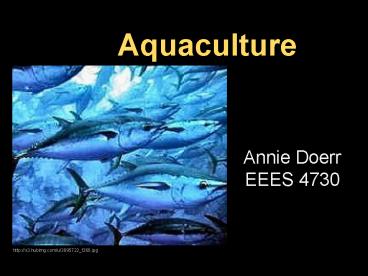Aquaculture - PowerPoint PPT Presentation
1 / 20
Title:
Aquaculture
Description:
Arial Office Theme Custom Design Aquaculture Goal : ... – PowerPoint PPT presentation
Number of Views:614
Avg rating:3.0/5.0
Title: Aquaculture
1
Aquaculture
- Annie Doerr
- EEES 4730
http//s3.hubimg.com/u/3095722_f260.jpg
2
Goal General Understanding of Aquaculture
- Origins
- Aquaculture today
- Benefits and concerns
- Possible solutions
3
Origins
- oxbow lakes
- reserviors
http//serc.carleton.edu/resources/2528.html
- monsoon waters
http//farwestsocialclub.com
- netted coves
http//www.anra.gov.au/topics/coasts/condition/ind
ex.html
http//www.africam.com/images/cam_info/nkorho_loca
tion.jpg
4
Recent History
- 50 seafood comes from aquaculture (SIC)
- Aquaculture contribution to seafood supply
increased from 3.9 (1970) to 29.9 (2002) (FAO)
5
Recent History
- Aquacultures growing faster than any other meat
industry - average growth since 1970
- aquaculture 8.9/yr
- fisheries 1.2/yr
- terrestrial meat 2.8/yr (FAO)
6
Recent History
- 4. Largest growth in China (FAO)
- 5. 2002 60 billion value in US
1970
2002
http//www.fao.org/docrep/007/y5600e/y5600e04.htm
p_1
7
Basics
- Aquaculture farming aquatic organisms (fish,
mollusks, crustaceans, aquatic plants) - Sources wild capture (20), hatchery (80) (FAO)
8
- freshwater culture(57.7)
- mariculture (36.5)
http//seasteading.org/interact/forums/engineering
/structure-designs/live-aboard-floating-platform-p
oor-aquaculture-a-susta
http//www.mannafoundation.org/maeteng/maeteng1.jp
g
- brackish-water (5.8)
- sea ranching
http//www.sciencephoto.com/media/375832/enlarge
http//www.prwatch.org/files/images/fishfarm.jpg
9
Benefits
- Decrease pressure on wild fish
- Less expensive than industrial fishing - better
human diets less unsustainable fisheries
10
Problems
- 1. Disease parasites - spread to wild fish,
antibiotics - 2. Fish feed - ? stocks, farming tigers, raw
feed spreads disease
- 3. Genetic pollution invasives - escaped
domestic fish
http//www.noteworthytips.com/wp-content/uploads/2
010/08/fish_net_8392.jpg
11
Problems
- 4. Loss of natural habitat - invasive captures,
farm location (20 mangrove destruction) - 5. Pollution from concentrated sewage - smother
benthos, eutrophication, ? DO
http//www.habitatadvocate.com.au/?taginshore-bea
m-trawl-fishery
12
Traditional vs. Integrated Multi-tropic
Aquaculture of Gracilaria chilensis
- 60 salmanoid feed stays in water
- Gracilaria chilensis (seaweed) removes amonia and
nitrates from water
http//www.texasaquaculture.org/
13
- Integrated aquaculture raising fish with
another crop
http//land.allears.net/blogs/jackspence/LWTL32.jp
g
14
Traditional vs. Integrated Multi-tropic
Aquaculture of Gracilaria chilensis
- Study examines potential of seaweed to filter
excess nutrients from salmon farms
15
- L1 800m - top
- L2 7km - top
- L3 control - top
- L4 bottom
16
Growth Patterns
summer
autumn
- Summer and autumn growth patterns (mean (SE), n
30) of Gracilaria chilensis cultivated at
different distances from the salmon cages (L1
100 m, L2 800 m, L3 7000 m and L4 bottom
culture). A. Relative Growth Rate ( day- 1) and
B. Productivity (g m- 1 month- 1). Letters
indicate the groups differentiated by posthoc
tests, when these were significant at P lt 0.01.
17
- Seaweed most effective floating at intermediate
distance - Farming seaweed near fish farms would reduce
nutrient outputs from aquaculture
18
Possible Solutions
- Integrated aquaculture
- Replace wild-caught fry with hatchery fry
- Better shipment and feeding methods
- Better labels for seafood
- "Eat food. Not too much. Mostly plants." -Michael
Pollan
19
Questions?
http//s3.hubimg.com/u/3095722_f260.jpg
20
Resources
- Food Agriculture Org. (FAO) http//www.fao.org/d
ocrep/007/y5600e/y5600e04.htmp_1 ,
http//www.fao.org/docrep/field/009/ag158e/AG158E0
1.htm , - Seafood Industry Council (SIC) http//www.seafoodi
ndustry.co.nz/aquaculture































